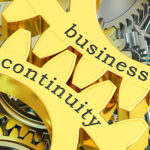
A business continuity plan is one of those topics that is frustrating to confront. It’s not terribly interesting and has very little practical value in the context of day-to-day operations, but it is intrinsically important to the sustainability of any business that happens to deal with problems. Consider for a minute how many businesses fared when the COVID-19 pandemic was in full force. There weren’t many businesses that had contingency plans for a “global pandemic.” The businesses that were quick to respond and adapt often came out on top, compared to businesses that struggled to commit.
What is a Business Continuity Plan?
Essentially the business continuity plan is exactly that: it is a strategy put in place that will allow a business to get back up and operational quickly after an event happens that causes interruption. Only part of a continuity plan has to do with your business’ technology, but since most businesses have built a major reliance on their technology to operate, understanding how it fits into their continuity strategy is essential to mitigate major problems if they do arise.
This isn’t always easy. In fact, the Federal Emergency Management Agency (FEMA) found that about a quarter of companies aren’t able to reopen if they are hit with a natural disaster that takes out their ability to operate. That percentage grows pretty rapidly the smaller your business is. Of course, having a plan in place to mitigate the effects of flood, fire, and other major disasters is pretty commonplace, but a lot of times there are just so many situations that arise during an interruption event that keeps a business from being able to completely recover.
Business Continuity Plans Need to be Flexible
Let’s disregard catastrophic weather events and look at a threat that has been causing massive amounts of downtime to even more businesses—ransomware.
In 2021, a whopping 37 percent of all businesses in the United States were impacted by ransomware of some kind. It’s worth pointing out that ransomware is constantly being improved (so it’s becoming more and more dangerous) and thus the amount of downtime and risk has only increased over time. When a ransomware attack strikes, it often disrupts business for several days. Depending on the severity of the attack, it could even steal your data, whether you are able to recover it or not. This type of situation requires a massive amount of work to identify what was stolen, communicate to partners, staff, and customers, and remediate the situation. This is only scratching the surface of how to respond to a data breach, but the point is, it’s a lot of work and a lot of disruption before a business can go back to normal.
A business continuity plan needs to have the pieces and processes to take this on.
Fortunately, for this type of disaster, the most fundamental IT piece of a business continuity plan is a pretty good first step in combating a ransomware attack. Restoring the impacted servers from a previous backup should eliminate the ransomware. This means your staff can get to work sooner, although the threat isn’t over yet.
You’ll need to work with cybersecurity experts (like Excedeo) to root out the source of the attack and determine the possibility of a breach, establish chains of communication, perform preventative actions to harden the network, etc.
On the other hand, let’s say a key individual in your organization suffers from a sudden health issue and is out of the box for 6 weeks. Your business continuity plan needs to account for the shift in command, the delegation of responsibility, and again, the communication involved to keep everything running smoothly.
Every Plan Needs an Iron-Clad Backup Strategy
Remember, you can’t benefit from the backup you don’t have.
If your business isn’t backing up its data, you are simply asking for risk.
Fortunately, we offer the world’s most comprehensive data backup solution. We back up everything on your servers as often as every 15 minutes, and store multiple versions so you can even grab files or directories from multiple revisions ago. Every night, we encrypt and archive the backup remotely in a secure data center. While this has become the standard, the real lifesaver is how our backup device handles restorations.
We’re able to restore files and directories easily, so if a user accidentally deletes or corrupts a file, that’s no problem. If your server crashes or fails, we can spin up a virtualized server from within the backup device. This means minimal downtime in the event of a disaster. Best of all, when a new server is set up, we don’t need to go through the arduous process of installing the OS, running updates, setting up the software, configuring everything, etc. We’re able to just transfer the virtual server onto the new hardware, avoiding hours of expensive labor.
Believe me, if you experience any kind of major issue, you’ll be so thankful you have us on your side.
Looking for help establishing your business continuity plan, and ensuring that your IT is prepared for any kind of surprise the world might throw at it? Give us a call at 619-776-3032
.